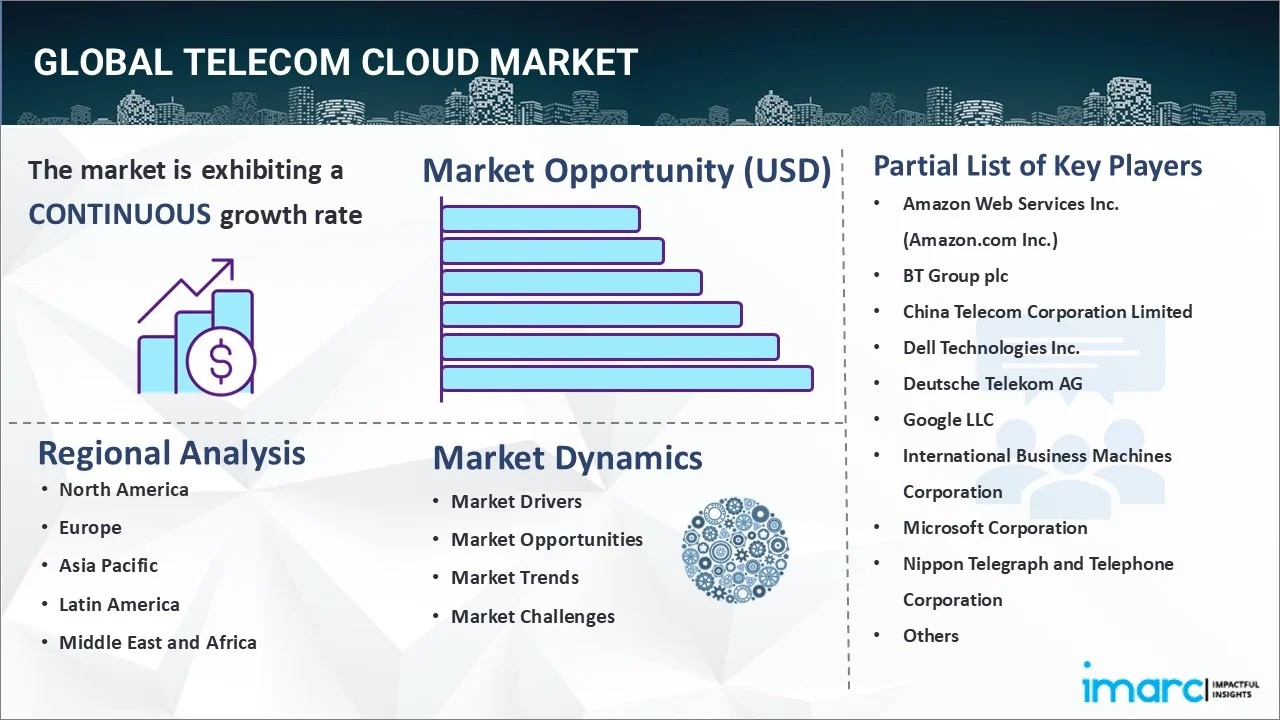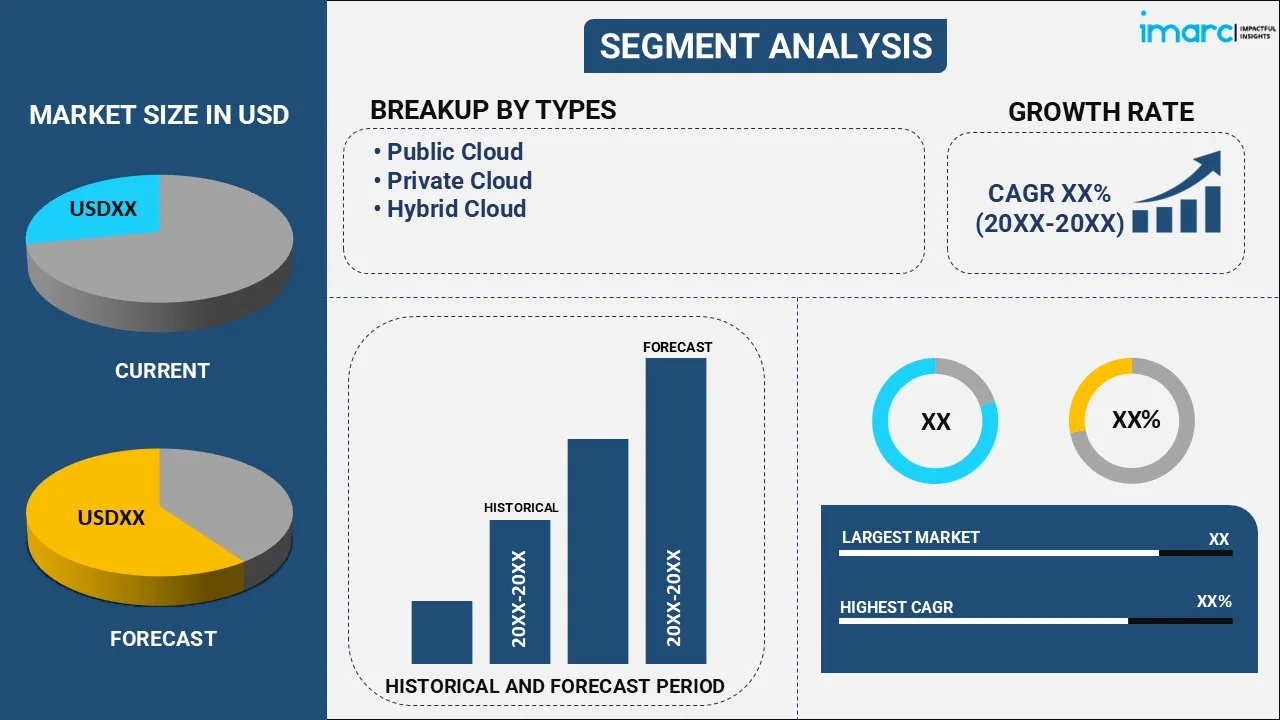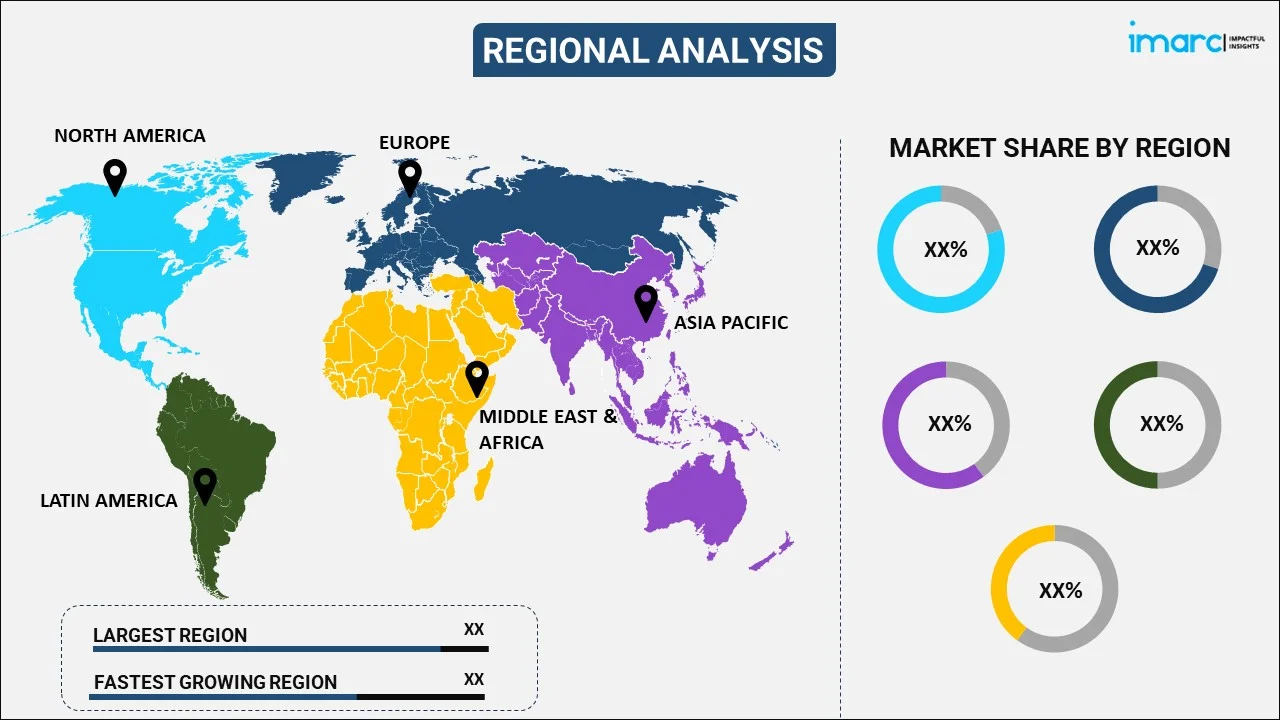
Telecom Cloud Market Report by Type (Public Cloud, Private Cloud, Hybrid Cloud), Computing Services (SaaS, IaaS, PaaS), Application (Computing, Data Storage, Achieving, Enterprise Application, and Others), End User (BFSI, Retail, Manufacturing, Transportation and Distribution, Healthcare, Government, Media and Entertainment, and Others), and Region 2025-2033
Market Overview:
The global telecom cloud market size reached USD 48.4 Billion in 2024. Looking forward, IMARC Group expects the market to reach USD 206.8 Billion by 2033, exhibiting a growth rate (CAGR) of 16.63% during 2025-2033. The increasing demand for scalable, cost-effective communication solutions, along with the rising need for enhanced network performances, widespread digital transformation and rapid increase in data traffic are key factors fueling the market growth globally.
|
Report Attribute
|
Key Statistics
|
|---|---|
|
Base Year
|
2024
|
|
Forecast Years
|
2025-2033
|
|
Historical Years
|
2019-2024
|
|
Market Size in 2024
|
USD 48.4 Billion |
|
Market Forecast in 2033
|
USD 206.8 Billion |
| Market Growth Rate 2025-2033 | 16.63% |
Telecom cloud is a term used to define the shift in the telecommunication industry from conventional machine-based landline services to cloud computing services. It enables the utilization of networking resources efficiently and provides unlimited network capacity to manage unpredictable data growth and offer an enhanced customer experience. It delivers immediate technical and profitable business values with minimal management effort or service provider interaction. Moreover, it facilitates the virtualization of storage, servers and networks, reduces the cost of infrastructure, and allows efficient sharing of resources. In recent years, telecom cloud solutions have gained traction across various industries, including banking, financial services and insurance (BFSI), healthcare, retail, media and entertainment, manufacturing, government, and transportation.

Telecom Cloud Market Trends:
Increasing 5G Integration
The telecom cloud market forecast indicates significant growth, primarily driven by the widespread adoption of 5G technology. 5G integration with cloud infrastructure is transforming the telecom industry by enhancing network efficiency and enabling ultra-fast, low-latency connectivity. Telecom companies are leveraging cloud-based solutions to deploy and manage 5G networks more effectively, allowing for scalable and flexible operations. For instance, in October 2024, Siemens and LS telcom partnered to provide private 5G wireless technology for industrial use. This collaboration aims to offer a comprehensive 5G solution for industrial customers, allowing them to operate a self-sufficient wireless infrastructure. The partnership includes consulting, licensing, planning, and complete implementation of the 5G network. The cloud provides the processing power required to handle the vast data generated by 5G, enabling seamless connectivity for applications such as autonomous vehicles, smart cities, and augmented reality. Additionally, cloud infrastructure supports the virtualization of network functions, reducing the need for physical hardware and improving the speed at which new 5G services can be launched and scaled.
Rising Adoption of Hybrid Cloud
Telecom providers are increasingly adopting hybrid cloud models to combine the advantages of both private and public clouds. This approach offers flexibility, allowing businesses to manage sensitive data in private clouds while leveraging the scalability and cost-effectiveness of public clouds for less critical workloads. Hybrid cloud solutions enable telecoms to provide secure and scalable infrastructures that meet the growing demand for data privacy, regulatory compliance, and diverse workload management. The widespread adoption of hybrid cloud models is expected to significantly increase telecom cloud market share, as it allows telecom providers to offer tailored solutions that balance data security, scalability, and cost efficiency. For instance, in October 2024, OVHcloud and Bouygues Telecom Entreprises announced their partnership to provide midsize enterprises with easy access to hybrid cloud solutions. This collaboration aims to help organizations define their cloud strategy and strengthen the security and resilience of their IT environment. By leveraging OVHcloud's expertise and infrastructure, Bouygues Telecom Entreprises aims to offer end-to-end support for cloud migration projects, ensuring optimized use of the cloud while controlling costs and reducing environmental impact. By integrating these cloud models, providers can optimize resource allocation, improve operational efficiency, and ensure robust security, catering to the needs of various industries while controlling costs and ensuring business continuity.
AI and Automation
According to telecom cloud market analysis, AI and automation are key factors driving the growth of the telecom cloud sector. AI helps optimize networks by predicting traffic patterns, adjusting resources dynamically, and enhancing bandwidth efficiency. Predictive maintenance allows operators to detect potential failures before they occur, minimizing downtime and reducing repair costs. Automation streamlines service delivery, from provisioning to billing, improving customer experience. Furthermore, AI-driven cybersecurity strengthens defenses against evolving threats by detecting and mitigating risks in real-time, ensuring secure network operations. For instance, in February 2024, Lenovo announced edge AI collaborations with major telecom providers. The initiatives aim to deliver AI workloads for customers, including smart city applications and sustainability efforts. Lenovo also unveiled purpose-built AI devices and infrastructure solutions with a focus on sustainability. These collaborations mark a significant step in bringing AI to the forefront of telecommunications and cloud technology. These advancements are contributing to the telecom cloud market growth further across the globe.
Key Market Segmentation:
IMARC Group provides an analysis of the key trends in each sub-segment of the global telecom cloud market report, along with forecasts at the global, regional and country level from 2025-2033. Our report has categorized the market based on type, computing services, application and end user.
Breakup by Type:

- Public Cloud
- Private Cloud
- Hybrid Cloud
Breakup by Computing Services:
- SaaS
- IaaS
- PaaS
Breakup by Application:
- Computing
- Data Storage
- Achieving
- Enterprise Application
- Others
Breakup by End User:
- BFSI
- Retail
- Manufacturing
- Transportation and Distribution
- Healthcare
- Government
- Media and Entertainment
- Others
Breakup by Region:

- North America
- United States
- Canada
- Asia-Pacific
- China
- Japan
- India
- South Korea
- Australia
- Indonesia
- Others
- Europe
- Germany
- France
- United Kingdom
- Italy
- Spain
- Russia
- Others
- Latin America
- Brazil
- Mexico
- Others
- Middle East and Africa
Competitive Landscape:
The report has also provided a comprehensive analysis of the competitive landscape in the global telecom cloud market. Detailed profiles of all major companies have also been provided. Some of the companies covered include:
- Amazon Web Services Inc. (Amazon.com Inc.)
- BT Group plc
- China Telecom Corporation Limited
- Dell Technologies Inc.
- Deutsche Telekom AG
- Google LLC
- International Business Machines Corporation
- Microsoft Corporation
- Nippon Telegraph and Telephone Corporation
- Oracle Corporation
- Singapore Telecommunications Limited
- Telefonaktiebolaget LM Ericsson
- Telstra Corporation Limited
- Telus Corporation
- Verizon Communications Inc.
Kindly note that this only represents a partial list of companies, and the complete list has been provided in the report.
Telecom Cloud Market News:
- In August 2024, Lambda announced a strategic partnership with SK Telecom to expand cloud services in South Korea. As a part of this endeavor, SK Telecom will deploy Lambda’s AI Cloud platform into SK Broadband’s Gasan data center, introducing a South Korea-based GPU cloud service. This move is expected to bolster SK Telecom’s leadership in AI services and capabilities while unlocking new business opportunities.
- In June 2024, Dell Technologies and Ericsson announced their partnership to facilitate the transformation of telecom networks to the cloud. By integrating their industry expertise with telecom software and solutions, the collaboration aims to guide communications service providers (CSPs) through their cloud transformation journeys, addressing concerns such as limited time and budget, reliability, and security. The partnership plans to develop tailored network cloud transformation plans, introduce Ericsson Cloud RAN software on Dell PowerEdge servers, and co-develop services to simplify deployment processes.
- In October 2023, Bharti Airtel (“Airtel”), one of India’s leading telecommunications service providers announced the launch of Airtel CCaaS (Contact Center as a Service) – an industry first omni-channel cloud platform that offers a unified experience for all contact center solution required by an enterprise.
Report Scope:
| Report Features | Details |
|---|---|
| Base Year of the Analysis | 2024 |
| Historical Period | 2019-2024 |
| Forecast Period | 2025-2033 |
| Units | Billion USD |
| Segment Coverage | Type, Computing Services, Application, End User, Region |
| Region Covered | Asia Pacific, Europe, North America, Latin America, Middle East and Africa |
| Countries Covered | United States, Canada, Germany, France, United Kingdom, Italy, Spain, Russia, China, Japan, India, South Korea, Australia, Indonesia, Brazil, Mexico |
| Companies Covered | Amazon Web Services Inc. (Amazon.com Inc.), BT Group plc, China Telecom Corporation Limited, Dell Technologies Inc., Deutsche Telekom AG, Google LLC, International Business Machines Corporation, Microsoft Corporation, Nippon Telegraph and Telephone Corporation, Oracle Corporation, Singapore Telecommunications Limited, Telefonaktiebolaget LM Ericsson, Telstra Corporation Limited, Telus Corporation, Verizon Communications Inc., etc. |
| Customization Scope | 10% Free Customization |
| Post-Sale Analyst Support | 10-12 Weeks |
| Delivery Format | PDF and Excel through Email (We can also provide the editable version of the report in PPT/Word format on special request) |
Key Questions Answered in This Report
The global telecom cloud market was valued at USD 48.4 Billion in 2024.
We expect the global telecom cloud market to exhibit a CAGR of 16.63% during 2025-2033.
The emerging trend of virtual environment, along with the increasing preferences for cloud computing services among various enterprises to enhance business agility and operational efficiency, are primarily driving the global telecom cloud market.
The sudden outbreak of the COVID-19 pandemic has led to the rising demand for telecom cloud services among the individuals working from home and obtaining education online, along with the growing popularity of OTT cloud services as indoor means of entertainment during the lockdown scenario.
Based on the type, the global telecom cloud market has been segmented into public cloud, private cloud, and hybrid cloud. Currently, public cloud holds the majority of the total market share.
Based on the computing services, the global telecom cloud market can be divided into SaaS, IaaS, and PaaS. Among these, SaaS currently exhibits a clear dominance in the market.
Based on the application, the global telecom cloud market has been categorized into computing, data storage, achieving, enterprise application, and others. Currently, computing accounts for the majority of the global market share.
Based on the end user, the global telecom cloud market can be segregated into BFSI, retail, manufacturing, transportation and distribution, healthcare, government, media and entertainment, and others. Among these, the BFSI sector currently holds the largest market share.
On a regional level, the market has been classified into North America, Asia-Pacific, Europe, Latin America, and Middle East and Africa, where North America currently dominates the global market.
Some of the major players in the global telecom cloud market include Amazon Web Services Inc. (Amazon.com Inc.), BT Group plc, China Telecom Corporation Limited, Dell Technologies Inc., Deutsche Telekom AG, Google LLC, International Business Machines Corporation, Microsoft Corporation, Nippon Telegraph and Telephone Corporation, Oracle Corporation, Singapore Telecommunications Limited, Telefonaktiebolaget LM Ericsson, Telstra Corporation Limited, Telus Corporation, and Verizon Communications Inc.
Need more help?
- Speak to our experienced analysts for insights on the current market scenarios.
- Include additional segments and countries to customize the report as per your requirement.
- Gain an unparalleled competitive advantage in your domain by understanding how to utilize the report and positively impacting your operations and revenue.
- For further assistance, please connect with our analysts.
 Inquire Before Buying
Inquire Before Buying
 Speak to an Analyst
Speak to an Analyst
 Request Brochure
Request Brochure
 Request Customization
Request Customization




.webp)




.webp)












